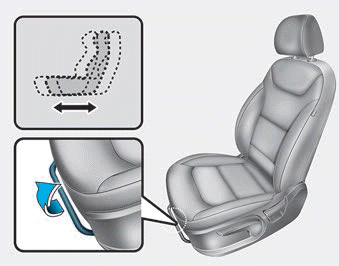Hyundai Ioniq: Hybrid System Overview / Charging the Plug-in Hybrid Vehicle
Charging Information
• Normal Charge :
The plug-in hybrid vehicle is charged by plugging into a normal charger installed in your home or a public charging station. (For further details, refer to the 'Normal Charge'.)
• Trickle Charge :
The plug-in hybrid vehicle can be charged by using household electricity. The electrical outlet in your home must comply with regulations and can safely accommodate the Voltage / Current (Amps) / Power (Watts) ratings specified on the portable charge.
Charging Time Information
Takes approximately 2 hours 15 minutes at room temperature. (Can be charged to 100%.)
• Trickle Charge :
For charging at home. Please note that Trickle Charger is slower than the Normal Charger.
Charging Types

- Depending on the condition and durability of the high voltage battery, charger specifications, and ambient temperature, the time required for charging the high voltage battery may vary.
- Actual charger image and charging method may vary in accordance with the charger manufacturer.
- Charging Status
- Charging Connector AUTO / LOCK Mode
- Scheduled Charging
- Charging Precautions
- Normal Charge
- Trickle Charge
 PHEV (Plug-in Electric Vehicle) System
PHEV (Plug-in Electric Vehicle) System
Plug-in Hybrid Vehicle
The HYUNDAI Plug-in Hybrid Electric Vehicle (PHEV) shares the characteristics
of both a conventional hybrid electric vehicle and an all-electric vehicle...
Other information:
Hyundai Ioniq (AE) 2017-2025 Service Manual: Components and components location
Components[General Type]1. Front seat headrest2. Front seat headrest guide3. Front seat back board4. Front seat back frame assembly5. Front seat shield inner cover6. Front seat SAB module7. Recliner lever8. Height lever cap9. Height lever 10. Front seat shield outer cover 11...
Hyundai Ioniq (AE) 2017-2025 Service Manual: Brake Actuation Unit. Repair procedures
Removal 1.Turn ignition switch OFF and disconnect the negative (-) battery cable.2.Disconnector TCM connector (A).3.Disconnector TCM connector (B).4.Loosen the bolt & nut (A) then remove the ECM, TCM with bracket (B).5.Remove the air cleaner.(Refer to Engine Mechanical System - "Air Cleaner")6...
Categories
- Manuals Home
- 1st Generation Ioniq Owners Manual
- 1st Generation Ioniq Service Manual
- Child-Protector Rear Door Locks
- Smart Cruise Control System
- Jump Starting
- New on site
- Most important about car
Manual adjustment
The front seat can be adjusted by using the levers located on the outside of the seat cushion. Before driving, adjust the seat to the proper position so that you can easily control the steering wheel, foot pedals and controls on the instrument panel.
Forward and rearward adjustment


